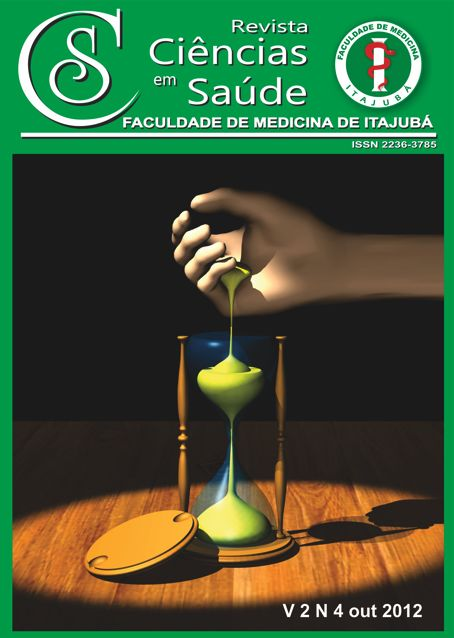Dados Clínicos dos Pacientes Cadastrados no Programa HiperDia, Itajubá, Minas Gerais, Brasil/Clinical Data of Patients Registered HiperDia Program, Itajubá, Minas Gerais, Brazil.
Main Article Content
Abstract
Objetivo: O objetivo do trabalho foi identificar os dados clínicos dos pacientes cadastrados no HiperDia, verificar a prevalência de doenças associadas e a ocorrência de fatores de riscos, de modo a traçar o perfil epidemiológico dos usuários do HiperDia na cidade de Itajubá, Minas Gerais. Materiais e Métodos: Utilizou-se como instrumento de pesquisa as fichas de cadastro do programa HiperDia de pessoas residentes no município de Itajubá. Utilizou-se a estatística descritiva para melhor compreensão dos resultados. Os dados coletados foram digitados no programa Microsoft Office Excel 2007 e foram utilizadas funções estatísticas para obter a porcentagem, com o erro populacional, de cada variável. Também foram realizados o teste qui-quadrado (não paramétrico) em relação aos fatores de riscos concomitantes e teste binominal. Resultados: Os fatores de riscos mais relevantes foram antecedentes familiares (64,2%) e sedentarismo (54,2%) e dentre as patologias, a de maior relevância é a hipertensão arterial (85,6%), seguida do diabetes tipo II (30,4%). Observou-se que um número, ainda que pequeno, de pessoas que buscam os serviços do Sistema Único de Saúde já possuem complicações e fatores de risco para hipertensão e diabetes. Conclusão: É necessário adotar medidas de aperfeiçoamento dos programas de prevenção; diagnosticar de forma precoce o agravo; diminuir os fatores de risco, conscientizando a população sobre tais doenças e hábitos saudáveis de vida.
Palavras chave: Diabetes, Hipertensão, Saúde Pública.
ABSTRACT
Objective: The aim of this study was to identify the clinical data of patients enrolled in the HiperDia, to determine the prevalence of associated diseases and the occurrence of risk factors in order to trace the epidemiological profile of users in the city of HiperDia Itajubá, State of Minas Gerais. Materials and Methods: It was used as a research tool the program registration forms HiperDia of people living in Itajubá city. It was used descriptive statistics to better understand the results. The collected data were entered into the Microsoft Office Excel 2007, using statistical functions to obtain the percentage, with the error population of each variable. Were also conducted "chi-square" test (nonparametric) compared to concomitant risk factors and binomial test. Results: The most relevant risk factors were family history (64,2%) and sedentary lifestyle (54,2%) and among the diseases, the most relevant is hypertension arterial (85,6%), followed by diabetes type II (30,4%). Regarding the presence of complications, Acute Myocardial Infarction followed by Cerebrovascular Accident (CVA) were the most outstading. It was observed that a number, even small, of people seeking the services of the Health System already have complications and have risk factors for hypertension and diabetes. Conclusion: It is still necessary to take measures for improvement of prevention programs; diagnose thepathology so early; reduce risk factors, sensitizing the population on such diseases and healthy lifestyles.
Key words: Diabetes, Hypertension, Public Health
Article Details
Authors maintain copyright and grant the HSJ the right to first publication. From 2024, the publications wiil be licensed under Attribution 4.0 International 
 , allowing their sharing, recognizing the authorship and initial publication in this journal.
, allowing their sharing, recognizing the authorship and initial publication in this journal.
Authors are authorized to assume additional contracts separately for the non-exclusive distribution of the version of the work published in this journal (e.g., publishing in an institutional repository or as a book chapter), with acknowledgment of authorship and initial publication in this journal.
Authors are encouraged to publish and distribute their work online (e.g., in institutional repositories or on their personal page) at any point after the editorial process.
Also, the AUTHOR is informed and consents that the HSJ can incorporate his article into existing or future scientific databases and indexers, under the conditions defined by the latter at all times, which will involve, at least, the possibility that the holders of these databases can perform the following actions on the article.
